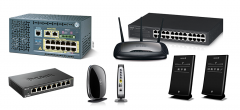A storage area network (SAN) is an architecture to attach remote computer storage devices (such as disk arrays, tape libraries, and optical jukeboxes) to servers in such a way that the devices appear as locally attached to the operating system. Although the cost and complexity of SANs are dropping, they are still uncommon outside larger enterprises.
Network attached storage (NAS), in contrast to SAN, uses file-based protocols such as NFS or SMB/CIFS where it is clear that the storage is remote, and computers request a portion of an abstract file rather than a disk block.
Sharing storage usually simplifies storage administration and adds flexibility since cables and storage devices do not have to be physically moved to shift storage from one server to another.
Other benefits include the ability to allow servers to boot from the SAN itself. This allows for a quick and easy replacement of faulty servers since the SAN can be reconfigured so that a replacement server can use the LUN of the faulty server. This process can take as little as half an hour and is a relatively new idea being pioneered in newer data centers. There are a number of emerging products designed to facilitate and speed this up still further. Brocade, for example, offers an Application Resource Manager product which automatically provisions servers to boot off a SAN, with typical-case load times measured in minutes. While this area of technology is still new many view it as being the future of the enterprise datacenter.
SANs also tend to enable more effective disaster recovery processes. A SAN could span a distant location containing a secondary storage array. This enables storage replication either implemented by disk array controllers, by server software, or by specialized SAN devices. Since IP WANs are often the least costly method of long-distance transport, the Fibre Channel over IP (FCIP) and iSCSI protocols have been developed to allow SAN extension over IP networks. The traditional physical SCSI layer could only support a few meters of distance - not nearly enough to ensure business continuance in a disaster. Demand for this SAN application has increased dramatically after the September 11th attacks in the United States, and increased regulatory requirements associated with Sarbanes-Oxley and similar legislation
The economic consolidation of disk arrays has accelerated the advancement of several features including I/O caching, snapshotting, and volume cloning (Business Continuance Volumes or BCVs).
Shrih Technologies provide a broad portfolio of storage networking services that address all aspects of deploying, operating, and optimizing your network.
Shrih Technologies Methodology for SAN
- Ensure that your network is ready to support a storage networking solution by getting help with assessing the security, resiliency, operation, and readiness of your network infrastructure.
- SAN Planning and Design Service can help businesses accelerate migration from discrete storage area networking (SAN) islands to an efficient, interconnected, intelligent SAN.
- Correct SAN implementation is critical to providing the reliability, availability, and consistent performance that SAN applications need. Our partners help create a SAN solution focused on your business needs and help make a smooth and successful transition to the storage solution you envisioned.
- Implement a successful data migration solution quickly and successfully










